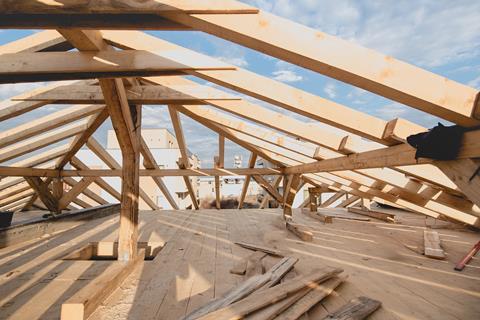As the STA prepares for the launch of its implementation document – a practical guide for those seeking to use timber frame systems – Housing Today spoke to Alex Goodfellow on the commerciality of structural timber, the readiness of the supply chain and what initiatives he hopes to see from government

Following the launch of the Timber in Construction Roadmap in December 2023, the Structural Timber Association (STA) is set to launch its Timber in Construction implementation guides in the hope of safely increasing the amount of timber used in construction to help the UK meet its net zero target by 2050 – as well as the government’s increased housebuilding targets.
“The implementation document will be useful to those wanting to use timber frames going forward,” explained Alex Goodfellow, chief executive officer at Donaldson Offsite. “As well as the more obvious and talked about reasons for building in timber – such as all matters carbon – offsite manufacturing is a good thing.”
Referring to the adage that time is money, Goodfellow highlighted the contrast between time needed on site when building in timber. “Most would say 15 weeks [to build a timber framed house]. But if you were to ask the major housebuilders [using masonry or concrete] how long it takes to build a house, they would probably say in the region of 26-30 weeks. That’s a three-month difference,” explained Goodfellow.
With the benefits of specifying timber-framed systems often focused on carbon calculations, the wider project benefits tend to be overlooked. Being less weather-dependent, fewer programme fluctuations, zero waste and nothing going to landfill were all mentioned as additional benefits. “Certainty of programme in the housebuilding market is very important,” added Goodfellow. “The just-in-time approach, installation method and project management allow housebuilders to build with greater certainty, in a shorter time and at a lower cost. There will be fewer penalties, less friction and less dissatisfaction in the sector – which always has a value somewhere.”
![Alex Goodfellow[1]](https://d224eigjcmsomk.cloudfront.net/Pictures/480xAny/0/9/5/1990095_alexgoodfellow1_973791.jpeg)
Goodfellow believes building with timber makes sense commercially: “Scots aren’t famed for doing things that cost more, and we’ve built 95% of our homes in timber, so I guess there’s something in that.” However, if the construction sector moves towards increased use of timber, the industry needs assurances that it will work. “Nobody likes surprises,” continued Goodfellow, “so it’s quite right that businesses embarking on change do so in a considered way.”
When asked what problems he anticipates seeing within the supply chain, Goodfellow shared that, at present, businesses manufacturing timber systems are not busy enough. One of the main messages the STA has been trying to communicate is that the timber industry is ready for a much greater capacity.
They are already seeing a swift change in the volume of timber houses built, with frameworks being developed in the affordable housing space, in readiness for more significant numbers in offsite manufacture (and timber). “As far as capacity is concerned, I’m not concerned about an increase in demand,” said Goodfellow, “it is what we are all hoping for.”
The UK does not produce enough timber to meet domestic demand, so it imports around 80% of its timber, mainly from the Baltic countries, including Sweden, Latvia and Finland. “The supply chain is strong,” said Goodfellow. “Regardless of what happens globally, the Swedish sawmills will support the UK market.”
The UK also has a homegrown timber market supported by several organisations, including the Confederation of Forest Industries (Confor). However, despite the commitment to increasing the output from UK forests, the volume that is required to service the UK construction sector is always going to require importing.

“It’s great that we have a policy now for more forestry, but the time it takes to go from policy to a mature forest that can then be harvested and replenished is a 40-year cycle,” said Goodfellow. He added that even with the additional carbon calculations arising from importation, his team can prove that building in timber is still significantly less impactful than building in concrete or steel.
“That’s why we have created this type of guidance,” explained Goodfellow. “Let’s go into the market and help those considering using timber more frequently and help them understand how to do it. Whether that be technical aid or construction methodology or ensuring you’ve done a thorough commercial viability assessment to ensure you’re making a very informed decision.”
Goodfellow feels optimistic about future legislation: “Hopefully, we now have a government that sees the housing sector as genuinely crucial for the country, for society and the economy.” He hopes to see some support for the housing sector through new initiatives to support growth, including work on the planning system, which is “badly in need of attention”.
“In short, the forests are well-sourced, well-managed and very sustainable. The manufacturers that buy from those forests are well financed and prepared to deliver a greater volume – and desperate to do so. The housebuilding industry seems more readily willing to buy and build in timber in higher volume.
“We don’t need to invent a new industry for this. All we need now is the demand we have all been waiting for.”
The STA collaborated with Timber Development UK and Confor as part of the Timber in Construction policy working group, but the STA alone produced the guides.










No comments yet